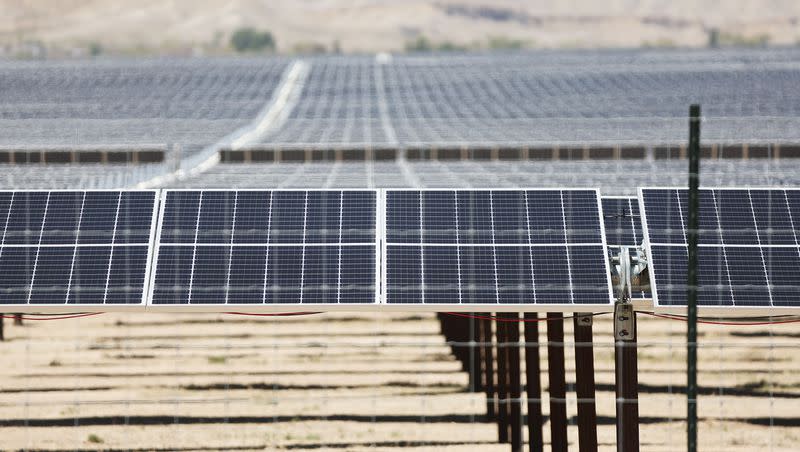More renewable energy, advanced nuclear energy planned for the West

A long-term resource plan released Friday by PacifiCorp anticipates a nearly fourfold increase in new wind and solar energy by 2032 and a system-wide 70% reduction of greenhouse gas emissions by 2030.
The 2023 Integrated Resource Plan was submitted to utility commissions in the six states Pacificorp serves, including Utah, and also includes an additional 7,400 megawatts of energy storage six years from now.
Officials say it advances a path toward a net zero future by targeting an 87% reduction in greenhouse gas emissions by 2035 and a 100% reduction by 2050.
The plan brought praise from Utah Clean Energy.
“The preliminary Integrated Resource Plan released today by PacifiCorp is an exciting advancement toward a reliable, modernized energy system powered by clean, renewable energy,” said Logan Mitchell, climate scientist and energy analyst at Utah Clean Energy.
“This plan clearly illustrates why renewable energy is the fastest growing energy resource in the United States — it is the best choice for our wallets, our health and our economy. We are thrilled to see the robust addition of more renewable energy to PacifiCorp’s system that will benefit all of us for generations.”
The utility company said its Western states’ emissions reductions will be even more accelerated in compliance with individual state emissions targets and clean energy requirements, particularly as regulations continue to clamp down on pollution from coal-fired power plants.
Controls to tamp nitrogen oxide emissions are planned for all of PacifiCorp’s five coal-fired units in Utah in 2026 to comply with the U.S. Environmental Protection Agency’s Ozone Transport Rule. That is among the regulatory and cost pressures influencing the earlier retirement of plants based on the plan’s modeling.
All of the Hunter Plant’s coal-fired units are anticipated to be retired by 2032, as well as the Huntington twin units in Emery County, Utah.
Related
How much money does renewable energy make for rural Utah’s economy? It’s more than you’d think
Rocky Mountain Power plans show transition from coal in favor of renewable energy
“We see a very unprecedented and rapid growth in the need for renewable energy on our system for the rest of this decade,” said Rick Link, senior vice president of resource planning, procurement and optimization for PacifiCorp. “So the numbers, not only are they large, but they’re at the pace at which we are going to be looking at adding these cost-effective resources that is also pretty astounding.”
The Utah Senate Minority Caucus also released a statement in response to the PacifiCorp plan.
“The expedited closures of Utah’s coal plants mark the beginning of a new era of opportunity for our state,” said Sen. Nate Blouin, D-Salt Lake City. “I applaud PacifiCorp’s commitment to a thoughtful, market-driven planning process and look forward to continuously working with the utility to ensure that any resources replacing the Hunter and Huntington plants fulfill the utility’s least-cost, least-risk mission.”
PacifiCorp is also adding transmission capacity in its service area to tap into the variability of weather so that wind generation developed in Wyoming travels elsewhere and robust solar power is sent where it is needed.
“It’s very rare, for example for the wind to not be blowing in one state at some given point and the same goes with solar,” where it may be hindered in one state by cloud cover but at optimal conditions elsewhere, Link said.
“That good geographic diversity in the system is through a robust, reliable grid that keeps the lights on,” and provides the energy for all sectors — commercial, residential and industrial — to function, he said.
Link said the addition of renewable energy is part of a 20-year plan that includes many factors.
“Our core objective is to say here’s how much load we have to serve, here’s where it is on peak. What’s the combination of resources, where should we locate them? How much should we add across our footprint? And when do we need to add them to make sure we’re reliable across every hour of the year for 20 years looking forward?”
Once that question is answered, those emission reductions are part of the “output” that is anticipated to be achieved through PacifiCorp’s preferred portfolio.
“So that’s kind of where we landed, picking the least cost portfolio got us to those emission reduction numbers that I mentioned,” he said.
Highlights of the plan include:
Investments in new resources and transmission are envisioned for multiple states from the West Coast to the Rockies.
In addition to the advanced nuclear reactor project selected by the 2021 plan for the Kemmerer, Wyoming, area to be in operation by 2030, the 2023 plan selected two more advanced nuclear projects which could be located in Utah near the currently operating Hunter and Huntington coal-fired plants.
Continued progress on demand response and energy efficiency programs, as the best energy is the energy that isn’t used.
Related
The coal to nuclear transition is an area of emphasis for both the federal government and states as coal is phased out as an energy resource amid increasing regulations, climate change and political pressure.
Link said PacifiCorp signed a memorandum of understanding with TerraPower for adding up to five fast sodium nuclear reactors featuring molten salt storage. TerraPower and GE-Hitachi are the companies behind the Wyoming project.
“We’re really kind of proud of how this story is unfolding. Again, with our plans showing that with these technologies coming online, this creates a great opportunity for adjusted reasonable transition,” Link said.
The plan is a roadmap or blueprint based on the best information available, which is why it is updated every two years.

